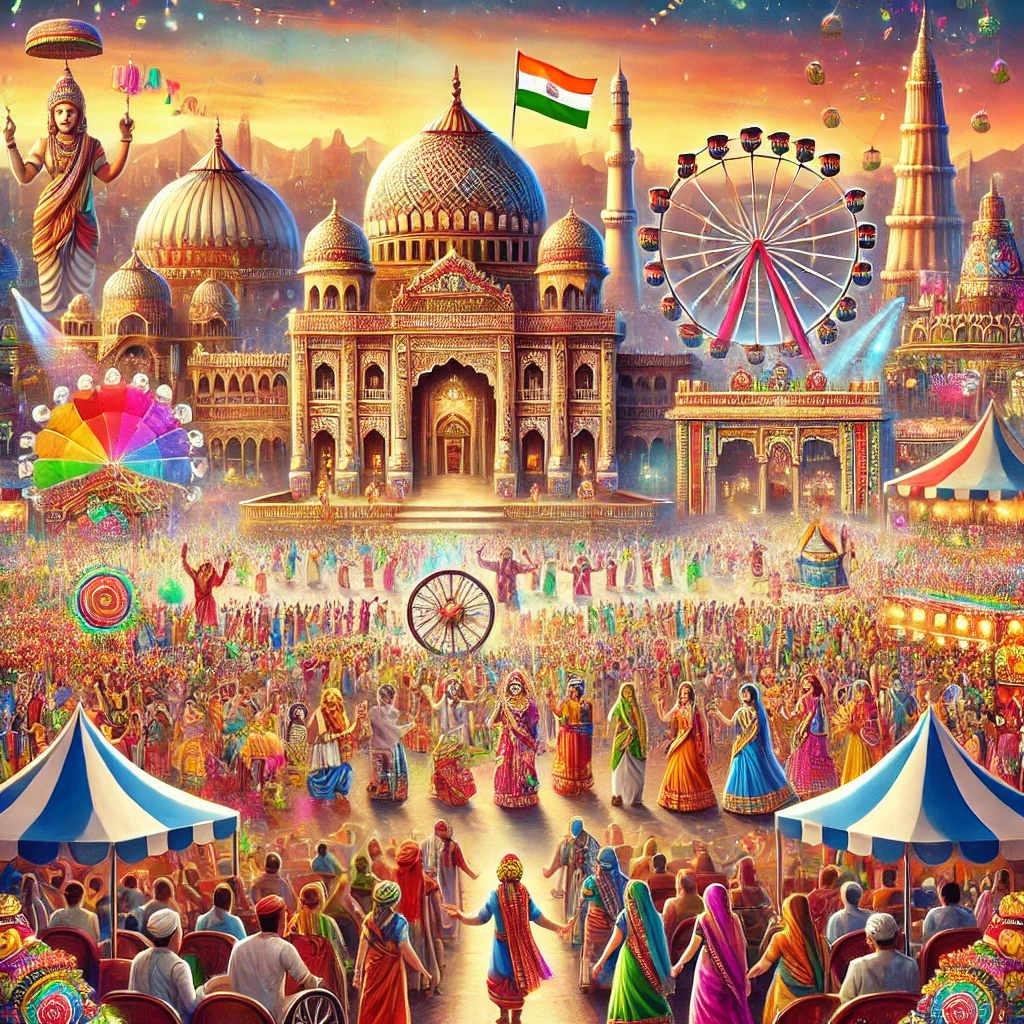Introduction
India, often referred to as the land of festivals, is a country where traditions, cultures, and religions intermingle to form a rich and diverse heritage. The role of fairs and festivals in maintaining India’s cultural diversity is significant, as these events serve as platforms for social cohesion, interfaith harmony, and the preservation of regional customs. From religious festivals like Diwali and Eid to cultural fairs like the Pushkar Mela and Hornbill Festival, India’s celebratory landscape is vast and dynamic. This article explores how fairs and festivals contribute to the sustenance and enrichment of India’s cultural diversity.
Religious Harmony Through Festivals
One of the defining features of India’s cultural fabric is its religious diversity. The country is home to multiple faiths, including Hinduism, Islam, Christianity, Sikhism, Buddhism, and Jainism. Each religion has its unique festivals, which not only strengthen individual identities but also promote interfaith interactions.
Celebration of Unity in Diversity
- Diwali (Hindu Festival of Lights): Celebrated across the country, Diwali signifies the victory of good over evil. It brings together people of all faiths, with non-Hindus often participating in the festivities by exchanging sweets and lighting lamps.
- Eid-ul-Fitr (Islamic Festival of Breaking the Fast): Marking the end of Ramadan, Eid promotes generosity and community bonding, with people from different religious backgrounds sharing festive meals.
- Christmas (Christian Festival of Love and Joy): Christmas celebrations in India go beyond Christian communities, with non-Christians often joining in the festivities through Christmas markets and cultural performances.
- Guru Nanak Jayanti (Sikh Festival Celebrating the Birth of Guru Nanak): This festival unites people through the practice of Langar, a community kitchen that feeds individuals irrespective of caste, creed, or religion.
These festivals play an essential role in fostering religious tolerance and strengthening communal bonds, as people from different backgrounds come together in mutual respect and celebration.
Preserving Regional Cultures Through Traditional Fairs
India’s diverse geography and ethnic groups have led to the evolution of region-specific fairs that showcase traditional crafts, performing arts, and local customs.
Prominent Cultural Fairs and Their Impact
- Pushkar Camel Fair (Rajasthan): A globally recognized livestock and cultural fair, it promotes Rajasthani folk music, dance, and attire while also serving as a major economic event for traders and artisans.
- Hornbill Festival (Nagaland): Known as the “Festival of Festivals,” it brings together Naga tribes to showcase their unique customs, dances, and crafts, thereby preserving indigenous traditions.
- Surajkund Mela (Haryana): This international craft fair highlights traditional Indian handicrafts and folk performances, encouraging artisans to sustain their heritage in the face of modernization.
- Kumbh Mela (Held in Different Cities): The largest religious gathering in the world, Kumbh Mela reflects Hindu spiritual traditions while also acting as a melting pot of cultural exchanges.
Fairs such as these are instrumental in preserving India’s regional cultures, providing a space where traditional art forms thrive and attract global recognition.
Economic and Social Impact of Festivals and Fairs
Festivals and fairs are not just cultural spectacles; they also serve as economic catalysts and social connectors.
Boosting Local Economies
- Employment Generation: Large-scale events provide temporary and permanent employment to local vendors, artisans, and performers.
- Tourism Growth: Festivals attract domestic and international tourists, boosting hospitality, transport, and retail industries.
- Promotion of Indigenous Crafts: Handicraft fairs provide artisans with platforms to sell their creations, ensuring the continuity of traditional crafts.
Strengthening Social Bonds
- Intergenerational Knowledge Transfer: Families celebrate festivals together, ensuring the transmission of rituals and stories from elders to younger generations.
- Community Participation: Local communities actively engage in organizing fairs, fostering a spirit of collective identity and pride.
- Inclusivity and Social Integration: Festivals transcend social barriers, uniting people across different economic and cultural backgrounds.
Adapting Traditional Festivals in Modern Times
With globalization and digitalization, Indian festivals and fairs have undergone transformations while retaining their core essence.
Contemporary Changes and Challenges
- Eco-Friendly Celebrations: Many festivals are now adopting sustainable practices, such as banning plastic decorations during Ganesh Chaturthi and promoting eco-friendly Holi colors.
- Virtual Participation: Digital platforms allow diaspora communities to engage in traditional celebrations even when living abroad.
- Commercialization Risks: While economic gains are beneficial, over-commercialization may sometimes dilute the cultural significance of festivals.
Conclusion
Fairs and festivals in India are more than just occasions for celebration; they are pillars of the nation’s cultural diversity. By fostering religious harmony, preserving regional traditions, boosting local economies, and strengthening social bonds, these events play a crucial role in sustaining India’s rich and pluralistic identity. As they continue to evolve with modern times, maintaining their authenticity while adapting to new challenges will be key to ensuring that India’s cultural diversity remains vibrant for generations to come.




